Spring in Door County
On this Wisconsin peninsula, a vast array of wildflowers rewards those weary of winter.
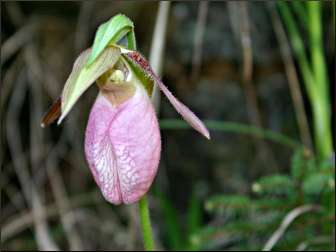
© Beth Gauper
Goldthread and gaywings. Bogbean and trailing arbutus. In Wisconsin's Door County, it's enough to make a naturalist hyperventilate.
Cherry blossoms and daffodils are the showiest spring flowers on this tourist playground between Lake Michigan and Green Bay. But it's the wildflowers, many of them rare, that provide the most joyous proof that spring has arrived.
On sandy ridges, the first flower spotted often is the once-common trailing arbutus, whose waxy white blossoms emerge in April.
"It's the first big sign of spring, and when it's in full bloom, it reminds me of Ivory dish soap," says naturalist Karen Newbern. "I usually find myself getting down on my knees and sticking my nose into them."
Every type of wildflower flourishes on this narrow peninsula, from the steep dolomite headlands along Green Bay to the bogs and beaches of Lake Michigan. But one spot is such a luxuriant showplace that it's practically the Tiffany's of wildflowers.
Along Baileys Harbor, 25 species of orchids grow amid 30 sand ridges, pushed ashore in a ripple pattern over 1,200 years. Separated by wetland strips called swales, they're home to species rare in Wisconsin.
The threatened dwarf lake iris grows here by the thousands, along with Arctic primrose, cancer root and ram's head lady's slipper. Cool lake breezes give this patch of land the characteristics of boreal forest, normally found much farther north.
"It's also called taiga," Newbern says. "We've had people from Sweden here who recognized the plants, and naturalists from Russia — their language was limited, but they could throw around the Latin names, so we had a common language."
Habitat for more species of plants than any other place in the state, it nearly became a trailer park in 1937. Local citizens protested, and the original 40 acres became Ridges Sanctuary; since then, the preserve has grown to more than 1,400 acres.
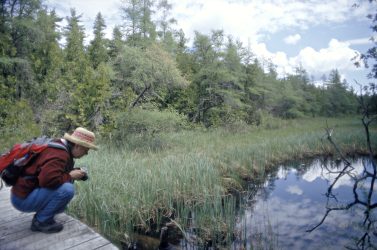
© Beth Gauper
It's a magnet for nature lovers in May, when it holds its three-day Festival of Nature, with naturalist-led field trips throughout the northern half of the county.
Looking for wildflowers
When I was there one year, I started out at the Ridges, with a walk led by Newbern and volunteer Cathie Mann.
From the visitors center, we walked down a boardwalk between two 1869 range lights that once allowed Lake Michigan sailors to get "on range" by lining up their fixed white and red beacons.
On the marshy land below, we could see the tiny lake iris, with yellow-and-white tongues amid purple petals. Today, they grow only in Michigan and three counties of Wisconsin.
"Because they like the shoreline, they've really suffered from development," Newbern said.
Across from the lower range light, at the edge of the beach, we found a cluster of wildflowers that included arctic primrose, Indian paintbrush, bastard toadflax and starry Solomon's plume. They were all on the petite side.
"If you ate nothing but sand, you'd be skinny, too," Mann said.
Life isn't easy for the plant life. On the beach, Newbern pointed out phragmites, a fast-spreading reed that chokes every native plant in its path.
"Picture crabgrass on steroids," she said. "That's what this stuff is; I kid you not."
From the beach, we walked along Sandy Trail lined with gaywings, whose bright-magenta sepals turn out like the wings of an airplane.
On Sandy Swale, Newbern pointed out bog rosemary and the red-veined leaves of a pitcher plant, which digests insects that crawl into its pitcher-shaped leaves and drown in the water that collects there.
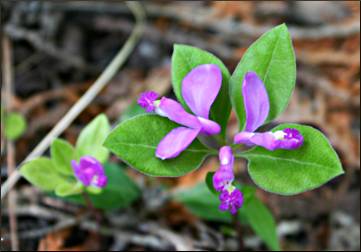
© Beth Gauper
On the Wintergreen Trail, we found a tiny goldthread and the leaves of the ram's head lady's slipper, the sanctuary's rarest and most elusive flower. It blooms in early June with the more-abundant pink moccasin and yellow lady's slippers.
Beside a boardwalk over Cowslip Swale, we saw a stand of bogbean, also called buckbean, whose star-shaped flowers were filled with crinkly, glowing white hairs.
We were nearly back to the visitors center when Newbern stooped to point out the asparagus-like stem of the striped coralroot, a cold-loving pinkish orchid that contains no chlorophyll or green leaves.
"That's why I like going with these naturalists; otherwise, I'd walk right by," said Teri Rycyzyn of Tinley Park, Ill. "It's wonderful, all these people willing to share what they know."
A walk through the trees
In the afternoon, I joined Mike Schneider's trees and shrubs walk on the other side of the peninsula, on the exposed western edge of the Niagara Escarpment.
Door Bluff Headlands Park, Schneider said, owes its untouched state to Jens Jensen, the landscape architect who, in 1935, founded the Clearing, the folk school Schneider now directs.
"Jens was on the five-man advisory board that had to decide what to do with it, and he said, 'Do nothing — keep it, and some day people will appreciate having it,' " Schneider said.
Clinging to dolomite cliffs high above Green Bay, gnarled white cedars were hundreds of years old but still no bigger than a bodybuilder's bicep. Schneider calls them "amazing survivors."
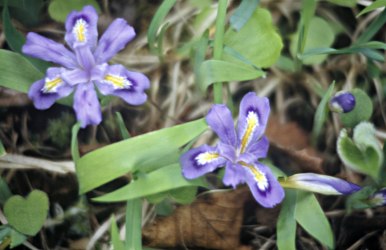
© Beth Gauper
"This has to be one of the most difficult environments in North America," he said. "There's hardly any soil, hardly any nutrients, and it's prone to deep freezes and drying winter winds."
Early French explorers called the trees arbor vitae, he said, because there's enough vitamin C in their leaves to cure scurvy.
We passed a wild black cherry, known as the potato-chip tree for its flaky bark; a white ash, used for baseball bats; and basswood, favored by decoy carvers. Schneider knew them all.
"I'm a tree fanatic," he said.
Cruise to Rock Island
Spring arrives first on the Green Bay side of Door County, surrounded by shallower waters that warm up faster. On the cooler Lake Michigan side, trees leaf out and wildflowers bloom one week or even two weeks later.
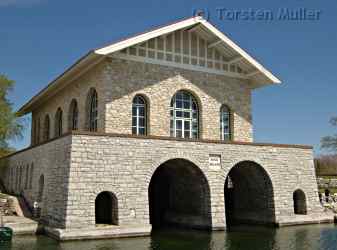
© Torsten Muller
"It's great," says Paul Regnier, former Ridges Sanctuary director. "If you're on the bay side, you can say, 'OK, these are gone, let's go to the lake side and see them there.' "
At Rock Island State Park, completely surrounded by water at the far tip of the peninsula, spring comes later still. Regnier led a Festival of Nature field trip to the island.
As we walked through maple-beech forest to the 1858 Pottawatomie Light, he told us why its uncluttered floor made it easy for him to spot wild leeks and the odd spring ephemeral.
"Alien worms brought in by the fishing industry are eating all the leaf matter," Regnier said. "They advance right through and eat things up. You take that away, and the whole forest changes."
On the sunnier parts of the island, however, Indian paintbrush flourished, carpeting the sandy paths leading to the beach.
The biggest splashes appear in May: scarlet paintbrush, bright white trillium and the shiny yellow lady's slipper, official wildflower of Door County.
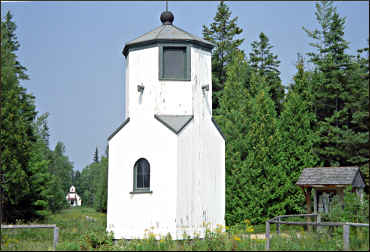
© Beth Gauper
"After living in this gray-green landscape, to get these bright colors, it's good for the soul," Regnier says.
All flowers are welcome in spring. But if you go to Door County in late May or June, try to find the little ones you may not see anywhere else.
"You have to make that annual pilgrimage down to your knees," Cathie Mann says.
Anyone can spot a daffodil. In Door County, you can spot just about anything.
Trip Tips: Spring in Wisconsin's Door County
Door County Festival of Nature: It's Memorial Day weekend.
For more, see Baileys Harbor in Door County.
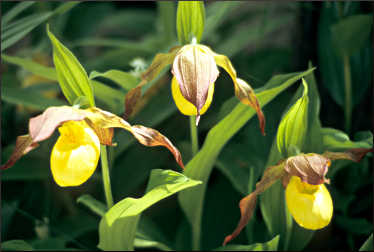
© Beth Gauper
Events: Memorial Day weekend, Fine Art Fair in Sturgeon Bay.
Accommodations: The county doesn't start to fill up until the last week of June, after schools are out and warmth is more reliable.
There are hundreds of B&Bs, cottages, condos, cabins and motels. For a guide, see Where to stay in Door County.
Camping: Campsites at Peninsula, Newport, Potawatomi and Rock Island state parks can be reserved 11 months in advance, 888-947-2757.
Potawatomi State Park has a disabled-accessible cabin that sleeps six and has a kitchen, bath and air conditioning, $30. To reserve, call 920-746-2890.
Classes: Check the schedule at the Clearing, a folk school in Ellison Bay, for such classes as "The Nature of Spring in Door County," "Bird Photography," "Spring Birds of Northern Woods and Waters"; and "Spring Rambles."

© Beth Gauper
For more, see Classroom in the Clearing.
Where to go: See Outdoors in Door County.
The Lake Michigan shoreline is lined by estuaries, beaches and forests, including those in Newport State Park, Wisconsin's only designated wilderness park.
Peninsula State Park, between Fish Creek and Ephraim, has a cedar-lined beach, hiking paths and paved bicycling trails.
Whitefish Dunes State Park, south of Jacksonport, has nature trails through sand dunes and along Lake Michigan.
Rock Island State Park, on an island reached by ferry from Washington Island, has an 1858 lighthouse, an Icelandic-style great hall and superb beaches.
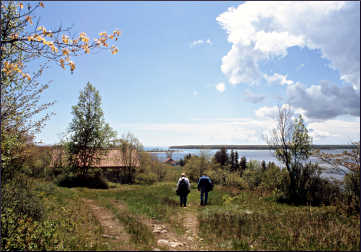
© Beth Gauper
Cave Point County Park, just north of Whitefish Dunes, is a good place to clamber around on the craggy shoreline.
The rustic Door Bluff Headlands County Park north of Ellison Bay has a spectacular view of Hedgehog Harbor over Green Bay.
Ellison Bluff County Park west of Ellison Bay also has a view from the top of 100-foot limestone bluffs.
Near Ridges Sanctuary off Ridges Road, across from the house with fire number 1981, a short drive leads to the trails of Toft Point Natural Area, where the family of environmentalist Emma Toft once ran a fishing camp.
There's canoeing and kayaking on the Mink River Estuary, and Nature Conservancy trails lead into the estuary from each side.
From County Road P/Mink River Road, watch for a green-and-yellow sign marking a small parking lot. From there, it's a beautiful hourlong walk through a corridor of cedars and maples.
The Northern Door, including Washington Island and Rock Island, has two dozen Wisconsin state natural areas.
On the headlands of Sturgeon Bay, Potawatomi State Park has many beautiful trails, including the first miles of the 1,000-mile Ice Age National Scenic Trail. In town, the nature preserve Crossroads at Big Creek has five miles of trails that fan out from a learning center.
Information: For more, see Door County stories.